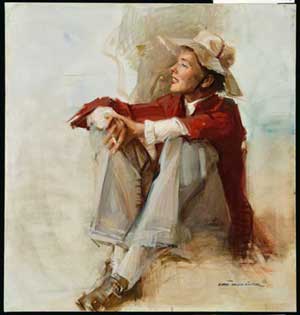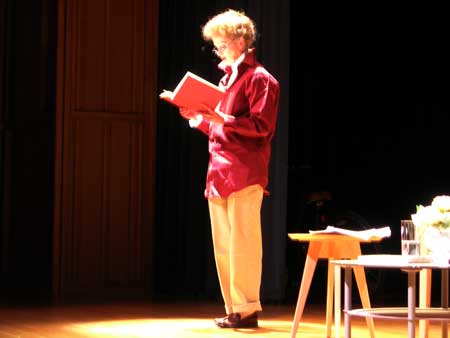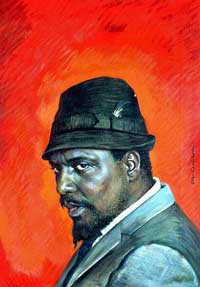Orson Welles and the 70th Anniversary of War of the Worlds
On Halloween night of 1938, Orson Welles brought to the airwaves the now-classic H. G. Wells’s fantasy War of the Worlds (1898). Many tuned in late, missing the announcement that the program was fiction. As viewers listened to aliens taking over Manhattan, panic set in, and Welles had to interrupt the broadcast to assure listeners it was not real.
Orson Welles is pictured here in a radio studio, at about the time he produced The War of the Worlds. This portrait is on display in the "20th Century American's" exhibition, on the museum's third floor.
Join us on Friday, October 31, at 1:00 p.m. as National Portrait Gallery historian Amy Henderson discusses Orson Welles and plays some selections from War of the Worlds. This day marks the seventieth anniversary of the Halloween radio broadcast that panicked America. The event is free and open to the public; please meet in the museum’s F Street Lobby.
In this blog post, Henderson tells us more about Orson Welles and his historic broadcast. This article is excerpted from her book, On the Air: Pioneers of American Broadcasting. You can listen to the War of World's broadcast, on this blog post, from the Smithsonian's "Around The Mall" blog.
Orson Welles first appeared on radio in 1934–1935, in NBC’s “The March of Time,” a kind of dramatized newsreel for radio sponsored by Time magazine. Even before Welles became well known, his ability to take on roles requiring any accent or age made him one of the most sought-after actors on radio; he once said that by 1935 he never earned “less than $1,000 a week as an unnamed, anonymous radio actor.” In 1937 he was chosen to be Lamont Cranston, the millionaire playboy who foiled evildoers by night in the adventure serial “The Shadow.” (Q: “Who knows what evil lurks in the heart of man?” A: “The Shadow knows…ha-ha-ha!”)
Welles’s theater work brought him into contact with John Houseman, and in late 1937 he and Houseman took over the tiny Comedy Theatre and ensconced their drama troupe in the newly renamed Mercury Theatre. The company enjoyed such success that Welles persuaded CBS to hire them to present a series of plays adapted from masterpieces.
Wells’s work with the Mercury Theatre would be his most innovative effort on radio. Here he created—as director, writer, and actor—the quintessence of what imaginative radio drama could be. With a cast that included Agnes Moorhead, Joseph Cotten, Martin Gabel, and Welles, the “Mercury Theatre on the Air” premiered on radio with Bram Stoker’s Dracula on July 11, 1939.
Programs based on Treasure Island, A Tale of Two Cities, The 39 Steps, Jane Eyre, and others followed in weekly sixty-minute installments. In September the “Mercury Theatre” moved into its regular time slot, opposite the hugely popular “Chase and Sanborn Hour,” starring Edgar Bergen and Charlie McCarthy; Bergen usually pulled in about 35 percent of the audience, while the “Mercury Theatre” would average 3.6 percent.
And so the stage was set for one of the most bizarre events in broadcast history.
For the Halloween program on October 30, 1938, H. G. Wells’s 1898 fantasy, The War of the Worlds, was scheduled. But chief Mercury writer Howard Koch considered the book so antiquated as to be laughable and set busily to work rewriting. Orson Welles joined him in the final rewrite, and somewhere along the line the key modernization occurred: use of the present tense and the addition of staccato-like news bulletins to plot the course of the Martians’ progress toward Manhattan.
The god of serendipity then joined the fray, ordaining that millions of listeners would twirl their radio dials immediately following Bergen and McCarthy’s opening monologue. As Bergen introduced a new and unknown singer, thwack! went dials all over America. When they tuned to the Mercury’s play, many failed to realize that it was, indeed, “play.” They had missed Welles’s warning at the beginning that it was all make-believe, and panic set in.
John Houseman later suggested that the public was made especially susceptible because the Munich crisis had taken place only a month earlier. Jitters grew as the horrific creatures were described pushing their way from Grover’s Mill to midtown Manhattan. Forty minutes into the program, CBS realized that all was not well, and at the break—with New York fictionally suffocating in poisonous black smoke—an announcer said, “You are listening to a CBS presentation of Orson Welles and ‘The Mercury Theatre on the Air,’ in an original dramatization of The War of the Worlds, by H.G. Wells.”
For the last twenty minutes, Welles narrated the denouement, with the Martians being killed by Earth’s bacteria—but by then, the damage had been wrought. As broadcast historian Erik Barnouw has pointed out, the event, although a high point in radio’s Golden Age of drama, was “in many ways a reenactment of The Fall of the City: men had rushed to prostrate themselves before an empty visor.”
An unrepentant Welles later said that the hoax was possible because of radio’s emergent importance: “The radio was believed in America. That was a voice from heaven, you see. And I wanted to destroy that as dramatically as possible.” Though the little practical joke had exploded out of hand, all that he had actually intended was an appropriate Halloween offering: “the Mercury Theatre’s own radio version of dressing up in a sheet and jumping out of a bush saying boo.”
Orson Welles/Unidentified artist, c.1938/Gelatin silver print/National Portrait Gallery, Smithsonian Institution


 April is
April is 


Recent Comments